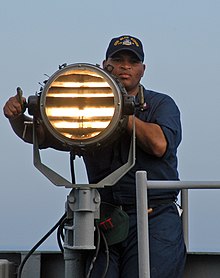Signal lamp
A signal lamp , and signal headlights or Morse lamp , after the inventor Arthur Cyril Webb Aldis also Aldi lamp called, is an optical telecommunications means by which messages, for example, Morse code (limited by the range) over short distances can be transmitted.
The term “lamp” is technically incorrect, as it is a luminaire in which a lamp is installed as a light source .
Signal lamps are mainly used in shipping . In the Navy - jargon , the device is often called a "flip book" (= "rattle-box" because of the shape and mechanics ). designated. A signal light must also be carried on merchant ships, but this is usually a hand lamp and not a permanently installed headlight.
Signal lamps can be designed as relatively small hand-held devices, but in practice they usually have a diameter of approx. 40-50 cm. They are equipped with a permanently switchable lamp (illuminant).
A distinction is made between directed light ( light beam ) and undirected light ( all-round light ). Projection optics are used for directed light , which on the one hand bundle the light beam and on the other hand make it difficult for unauthorized persons to “read” the message.
Often the devices are equipped with a simple sighting device in order to reach the recipient safely. In most cases, a lamella shutter is attached in front of the light exit opening, which can be opened and closed by the operator using a lever in order to generate the characters (see photo). This is necessary because stronger bulbs react too slowly when switched on and especially when switched off (the filament has to cool down) in order to be able to follow the signs quickly enough. This would wash them out. For small services, e.g. B. Flashlights, this is less of a problem. The shutter mechanism also allows continuous light sources, e.g. B. to use kerosene lamps or gas discharge lamps as illuminants.
Small signal lamps
These are devices that show the operating states of machines (switched on ?; switched off?).
Others

Armed forces, police, rescue services, etc. are equipped with hand lamps which, in addition to white light, can also emit colored light (mostly red and green; through color discs that can be connected up front). These serve for the simple and fast transmission of commands (vehicle instructions, stop signals, driving signals, etc.).
literature
- Günter Fietsch, Heinz Kösling: Communication technology of the National People's Army. Part 1: Radio equipment and antennas 1956–1990. Verlag für Technik und Handwerk, Baden-Baden 1993, ISBN 3-88180-318-1 , pp. 169-170.
- Ferdinand Hein: Operate Sp Dr 60 signal boxes - in regular operation. 3. Edition. Eisenbahn Fachverlag, Mainz 2000, ISBN 3-9801093-0-5 , pp. 40–45.
- Rainer Dohlus: light sources. Walter de Gruyter, Berlin / Munich 2015, ISBN 978-3-11-035131-6 , pp. 106-107.
Individual evidence
- ↑ Wolfgang Fenner, Peter Naumann, Jochen Trinckauf: Railway safety technology. Controlling, securing and monitoring routes and speeds in rail traffic. 2nd Edition. Publicis Publishing, Erlangen 2004, ISBN 3-89578-177-0 , pp. 111-125.
- ↑ Herbert Franken: Contactors and contactors controls. Springer Verlag, Berlin / Heidelberg 1959, p. 215 (example control).
- ↑ Otto Zinke , Hans Seither: Resistors, capacitors, coils and their materials. Springer Verlag, Berlin / Heidelberg 1982, ISBN 3-540-11334-7 , p. 32 (example household).
See also
Web links
- Visual Signaling In The Royal Australian Navy
- Signal lamp for motor vehicles (accessed January 5, 2018)

